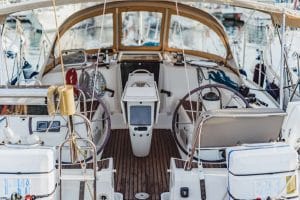The ship's crew It is made up of a series of professionals, each of them with their own functions and tasks in navigation. Equipment components may vary depending on the type of boat, its characteristics and the needs around the loading and transportation of goods or people, but there are certain roles that are not usually missing on the ship.
In many cases, outside the maritime field, each of the functions that depend on a specific member of a ship's crew, even though we have all heard of them. Below, we address each of these roles in detail that allow us to understand how navigation works.
In this article we develop and explain all the ranks that exist in the merchant navy so you can have more information.
The captain of the ship as the main rank
He Captain of a ship is the crew member who directs and coordinates the rest of the crew.. He is the one in charge of organizing tasks, distributing them and supervising them, taking responsibility for aspects such as direction and navigation safety, in addition to cargo management. His role is developed almost entirely on the deck of the ship.
The helmsman, who is in charge of steering the ship
To understand the role of the helmsman in the crew of a ship We could say that he is the pilot. In fact, it is called that because it is the member in charge of direct the helm of the ship, although it is also called first officer because it is a common position in this rank. Occasionally, in smaller vessels, the helmsman can assume the duties of captain.
The skipper, in boats without a captain
He master of a ship is like the captain, but on a smaller scale. That is to say, he acts as a captain, but he can only do so on specific vessels, generally on merchant, offshore or fishing vessels, as long as they do not exceed 1600 GT. In this sense, there are various types of patterns depending on the boat, As the port skipper or the coastal pattern, among other examples.
The boatswain to coordinate the sailors
The boatswain is in charge of coordinate the sailors that make up the rest of a ship's crew. This is a subordinate of the captain who, in many cases, acts as an intermediary between this figure and the other crew members, in addition to take responsibility for the ship's rigging and report any incident on board.
Sailors, a multifunctional profile
Below the boatswain are the sailors, the largest profile in the crew of any ship. They are in charge of various functions under the orders of the captain, the skipper or the boatswain himself, mainly maintenance, guards, quartermaster and any other requirements for which they are qualified.
Are you interested in: Basic Training Course in Maritime Safety
The chief engineer, who heads this department
If we look beyond the bridge or deck of the ship We find the engine room, where we can also identify a command profile called chief engineer. This role is responsible for direct, maintain and supervise the department, although on smaller ships it is possible that he or she will be the only person on board for the development of complete management.
Engineer officers to ensure the operation of the ship
The Engineer officers are members of a ship's crew below the chief engineer. in the hierarchy established by the General Directorate of the Merchant Navy. Depending on the size of the ship there can be three ranks of officers in the engine room: first, second and third officers, in charge of the guards and proper functioning from the Department.
Other common positions in the crew of a ship
Beyond these usual roles, there are other roles that are not always present on a boat. This does not mean that these functions are not developed, but rather that they can be performed by another member of the crew or that are necessary only occasionally, depending on the vessel and its operations.
Telecommunications officer
The telecommunications officer, also known as radio officer, is in charge of external communication systems on a vessel. Their functions are closely linked to safety on board, in addition to the possible commercial operations of the ship; The captain will act as telecommunications officer when a crew member dedicated exclusively to this is not necessary.
flight attendant
Regardless of whether we are talking about the transfer of goods or the transport of passengers, The purser is the main person responsible for the loading of a ship. This involves the reception, inventory, location, security, conservation and delivery of the merchandise. Logically, in small ships it is not an essential role.
Specific teachings based on needs
The specific skills or roles They are generally occupied by sailors specialized in specific functions, which in some cases are essential and in others unnecessary. We are talking about firefighters, plumbers, electricians, cooks, stewards, boilermakers or butlers who provide their services on board the ship.
The crew of a boat, an essential team
The members of a ship's crew, regardless of what roles make up the team, they must work in tune and coordinated with each other to ensure optimal navigation. In fact, although the functions are perfectly defined, collaboration between different crew members is common when carrying out the work.





